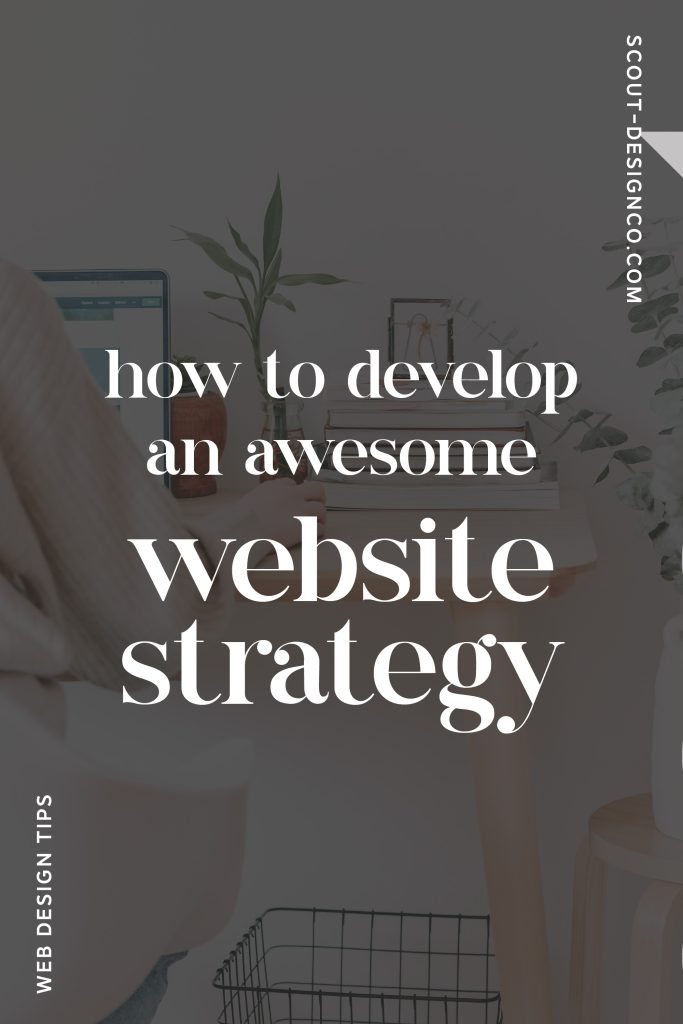Website strategy is a major buzz word in the web industry these days. But what exactly does it even mean? And is it really all that important?
Good design solves a problem and to solve a problem well, you must implement a strategy. While looks and style are key in creating a successful website, they’re only half the equation.
What is a website strategy?
A website strategy provides a foundation for the design and ensures that your website isn’t only going to look good, but also help you achieve the goals you have for your business. The strategy acts as a guide and ensures each design decision has a strong intention behind it. Without a website strategy, your design could be fruitless.

So what makes up a good website strategy?
There are 5 components that should be considered when developing your website strategy: Your goals, your target audience, user experience, your competition and design style.
1. Your goals
In order to measure your website’s success, you need to have some kind of benchmark in place. You should have a primary goal and a secondary goal for your website. These goals can be determined by your business objectives. Is your objective to bring in a certain amount of revenue? To build brand awareness? To become the leader in your industry? Consider what you’re striving for in business and think of how your website could assist in making that happen.
If you want to make more money, your website’s goal should be to book clients or sell your product. If you want to be seen as an authority in your field, focusing on resourceful content (like a blog or podcast) can be beneficial.
It’s common to have more than one objective in business, so it’s possible both of these things can apply. That’s why having a secondary goal for your website is so important.
It’s every business’s objective to make money and so the primary goal of your website is usually pretty obvious – make more sales. Ideally, you want the user to buy your product, enroll in your course or book a consult call. But what if they’re not quite ready to do that?
This is where a secondary goal comes in. If your audience isn’t ready to click Buy Now, how can you help make that decision easier for them? What else can you offer so they understand you’re the best solution to their problem?
A common secondary goal is signing up for your email list. This is a fantastic way to stay on top of mind, nurture warm leads, provide helpful resources and hopefully make the sale at a later time. Content, like a blog or podcast, is a great way to establish your expertise and credibility. By showing potential buyers you know your stuff, you can help an interested audience get off the fence and fill out your contact form.
These website goals should be the foundation of your website strategy. They’ll help you determine what your call-to-actions should be, where and how often you place them and how you can use design to lead user’s to performing these actions.
2. Your target audience
Your target audience is a crucial part of your website strategy – after all they’re the ones you need to impress in order to make any sale. Consider the reasons they’re coming to your website in the first place, what are they hoping to find? Make sure those things are easy to find and attractive to click on.
Understanding who your audience is helps determine what kind of content your website should include. If you’re a business coach, user’s are most likely coming to your website to find if you’re the right coach for them. Information about the structure of your program and what’s included will be key factors in their decision and therefore should be listed on your sales page. If you’re selling luxury, hand-made soaps at a high price point, user’s probably want to know why your soaps are worth the expense. A section highlighting your quality ingredients and the detailed manufacturing process will be important.
Your audience also helps with the kind of language you’ll use throughout your site as well as what kind of images. If your target demographic is millennials, it won’t make much sense to have images with people of an older generation – they won’t resonate. If you’re a real estate agent with an audience of “homebuyers”, photography centered around families will connect with them on an emotional level and help them visualize their future if they choose to work with you. This may seem pretty obvious, but it can sometimes be difficult to see beyond the thing you’re selling and instead see who you’re selling it to. With your target audience always in mind, you’ll be able to make design decisions that connect with them and lead to more sales.
3. User experience
A good user experience ensures that your website is easy and enjoyable to use. A confused user rarely turns into a buying customer.
Consider the journey you want users to take through your website and use that to create a smooth experience. A good starting point in planning out the user journey is creating a site map. A site map is an organizational chart of all your website’s pages. This will help you see what information should have its own page vs just a section of a page, group related pages together and prioritize the pages that are most important to the user.
You can then map out a journey that makes the most sense for your audience. For example, learning about who you are and your credentials could be a necessary first step to gaining trust with your audience and engaging them in the services you sell. So, make sure your About page has a call-to-action leading to your Services page. If you offer creative services or a result-driven service you probably have a portfolio of work or case-studies to show. This kind of “proof” could be a key factor in a purchasing decision, so it would make sense to link to a relevant case study after introducing your service. It’s also possible a user would check out your work before your sales page to see if your style is a good fit for them. So having a call-to-action leading to your Services page from your portfolio makes that transition easy.
Your website’s navigation should be straightforward and contain 5 links or less. Again, think about what your audience is coming to your website to find and make sure the top 3 things are listed in your main menu. Utilize drop down menus to organize related pages while simplifying your menu.
Always have a Contact button easy to find in case a user wants to reach you with any questions. If your business has a physical location, that address should be impossible to miss.
Hierarchical content is another aspect of user experience. No one is going to read a long paragraph of small text. No one. Make your copy short and easy to digest. Utilize headings and subheadings to organize content and make it skimmable. Make buttons clearly clickable and attractive. Ease of use is the name of the game.
Your target audience should be top of mind in user experience (understanding your audience is huge!). Think of ways you can make their time on your website easier, smoother and more enjoyable. If you know your audience comes to your site often looking for your latest sale, include sale items at the top of the page or a link to “sale” in an announcement bar or pop up. If your blog has many categories, consider implementing a filter system that makes it easy to sort through content. “Featured category” sections can also be helpful in promoting popular or seasonal posts.
4. Your competitors
Analyzing your competitor’s websites is beneficial in several ways. By seeing what areas your competitors are doing well in, you can gain insight into what elements your website should definitely include. You don’t want competitors having an advantage because they include information that you don’t, or offer resourceful content that you don’t or have a more modern design aesthetic.
It’s also important to note where your competitors may be falling short and find ways in which you can do something “better”. You can take advantage of the areas where they might be lacking. Like if your competitors aren’t promoting their email list, that’s something you can do to stand out. Create a free download users can access in exchange for their email address. You’ll be providing value, establishing your authority and growing your own list for future marketing efforts. Maybe you notice a similar product-based company has a clunky checkout process. By implementing a quicker, smoother process of your own you’ll create a better user experience and keep customers coming back to your site.
You also want to notice ways in which you can differentiate yourself from others in your industry. Use different design layouts, font sizes, buttons styles, etc. to guarantee your site can’t be confused with someone else’s. It can be easy to fall into design trends, but try to think of ways that you can do things differently.
5. Design style
Design style is last on the list because it’s helpful to work through the other 4 components first. Your audience, competitors and user experience will offer guidance in the design direction you should take with your site.
What styles will resonate with the users on your site? This will differ for a younger audience vs an older one, a female audience vs male.
How can user experience be applied to design? The most important content should be the easiest to find and easiest to read. These sections should use simplified layouts and images or graphics to draw attention to them. A feature like a slider or accordion could be useful in displaying lots of content in a smaller space.
When thinking about design style, notice what’s trending, but be careful. Modern design is key to looking current and professional, but you don’t want to fall into the trend trap. Using design elements that are trendy run the risk of looking like everyone else. It’s also very possible you’ll find yourself needing to redesign your website next year because you now look outdated. Try to stick to a clean, timeless design foundation and think of ways you can sprinkle more trendy elements in here and there.
Website strategy ensures the design and functionality of your site align with your goals, connect with your audience and help you stand out in the sea of competition. It also guides the design process, ensuring each design decision has a clear intention behind it. A successful website starts with a successful website strategy.







